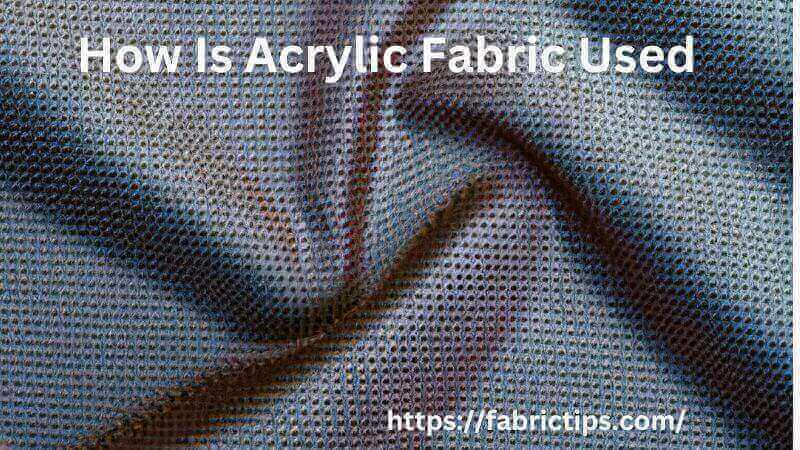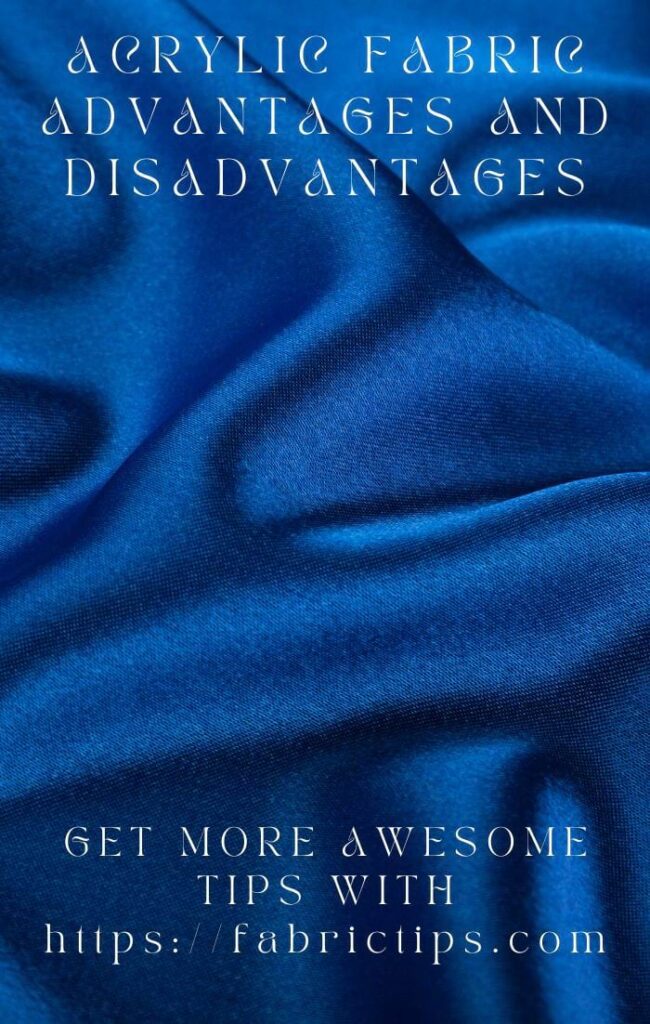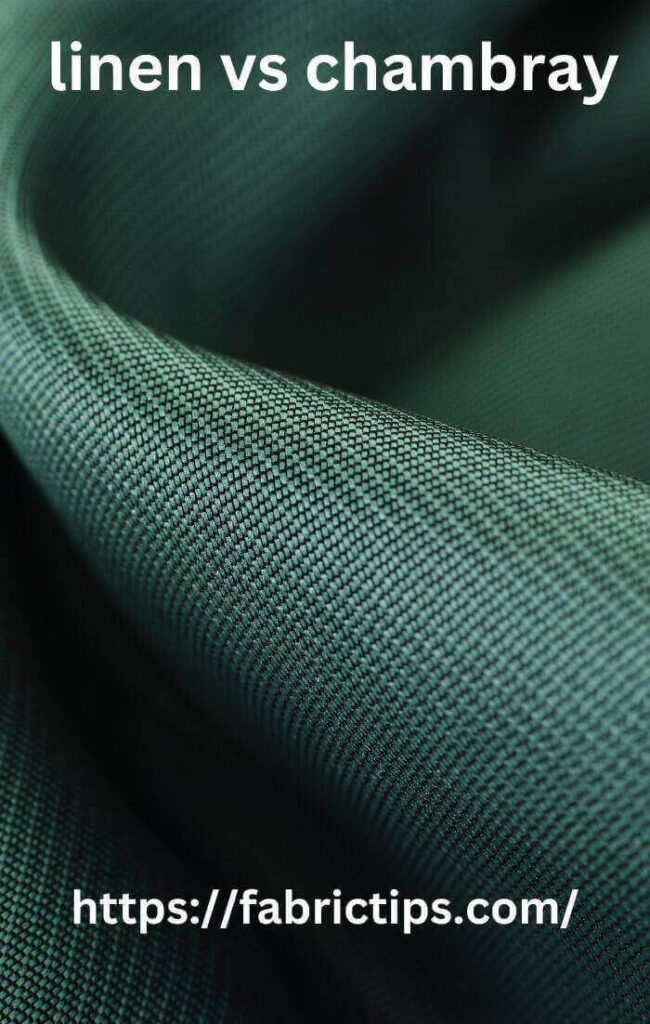Last Updated on December 13, 2025 by Wahid
Textiles made from acrylic fibers are called acrylic fabrics. In order to produce these fibers, a polymer is used called acrylonitrile, a petroleum-derived material. The advantages of acrylic fabric include its softness, warmth, and durability, and how well it retains color.
Actually, what is Acrylic fabric? Generally, the use of acrylic fabric is preferable to wool, since it is less expensive but has similar properties. The fabric can be knitted or woven into different textures and patterns, making it popular for clothing, upholstery, awnings, and tents, as well as indoor fabrics. Fabric made from acrylic is also resistant to mildew, fading, and insects, making it an excellent choice for outdoor applications.
However, synthetic fibers are less breathable than natural fibers such as cotton and wool, which can make them feel uncomfortable in hot, humid weather. Well, let’s see the detailed explanation of acrylic fabric below.
History Of Acrylic Fabric

Early in the 1940s, Acrylic fabric was introduced as an alternative to wool. For the duration of World War II, military uniforms were scarce with wool. It was developed as an affordable way to make a durable and warm fabric using acrylic fibers.
Initially, acrylic fiber was produced commercially in the United States in 1950, by companies such as DuPont and Monsanto. It quickly became popular as an affordable and versatile alternative to natural fibers. The fashion industry began to use it widely for clothing & accessories.
As early as the 1960s, acrylic fibers became softer & more comfortable thanks to technological advances. In fashion as well as home decor, acrylic fabrics became increasingly popular. Acrylic fabrics are used in a variety of applications, including apparel, upholstery, outdoor fabrics, & industrial textiles.
How Is Acrylic Fabric Made?

Synthetic fibers made from acrylonitrile are called acrylic fabrics. The process of making acrylic fabric can be summarized as follows:
Polymerization: During the polymerization process, acrylonitrile is used, converting to polyacrylonitrile, a long chain molecule. A polymerization reaction between acrylonitrile and other chemicals takes place, usually with catalyst assistance.
Crimping: After the fibers have been crimped, they are given a natural-looking texture. In order to set the crimp, fibers are heated and moistened. In some fibers, this is a permanent feature, while in others, it is temporary.
Spinning: Once dissolved, the polyacrylonitrile is mixed with a solvent, which is then spun into fibers by a spinneret, a small device for spinning fibers. By drawing out and stretching the fibers, the molecules are aligned & their strength is increased.
Finishing: A finished product’s fiber is washed, dyed, & woven into yarns, fabrics, and other products. It is possible to make a wide variety of products from acrylic fabric, including clothing, outdoor fabrics, upholstery, and industrial textiles.
Nevertheless, Acrylic fabric is considered to be soft, warm, and durable, as well as having good color retention. Moreover, it is resistant to fading, mildew, and insects, which makes it an excellent option for outdoor use.
How Is Acrylic Fabric Used?

Acrylic fabric is used in a variety of applications due to its versatility and durability. Here are some of the most common uses of acrylic fabric:
Clothing: Acrylic fabric is often used to make sweaters, scarves, hats, and other cold weather apparel due to its warmth, softness, and lightweight.
Home Decor: Acrylic fabric is used for upholstery, curtains, and bedding due to its durability, resistance to fading and mildew, and easy care.
Outdoor Fabrics: Acrylic fabric is often used for awnings, patio furniture, and outdoor cushions due to its resistance to water, mildew, and fading.
Industrial Textiles: Acrylic fabric is used in various industrial applications, such as filtration, insulation, and conveyor belts, due to its strength, heat resistance, and chemical resistance.
Carpeting: Acrylic fabric is sometimes used in the manufacture of carpet fibers because it is durable, resistant to staining, and can be made to look like natural wool.
However, Acrylic fabric is a popular choice for these applications due to its many desirable properties, including softness, warmth, durability, and resistance to water, mildew, and fading.
Where Is Acrylic Fabric Produced?

Around the world, acrylic fabric is manufactured in a number of countries. There are many countries that produce acrylic fiber, including China, Japan, the U.S., and European countries like Germany and Italy.
- Acryl fabric production requires high levels of technical expertise & infrastructure. It includes the availability of petrochemical feedstocks, specialized machinery to spin and process fibers, and a high level of quality assurance.
- Therefore, acrylic fabric is available in many nations with advanced petrochemical industries & textile manufacturing sectors.
- In recent years, acrylic fabric manufacturing has become more globalized. Increasingly, manufacturers are outsourcing their manufacturing operations to lower-cost countries with more conducive business environments.
- Thus, the acrylic fabric is produced in a number of countries, which makes it difficult to pinpoint a single production center.
How Much Does Acrylic Fabric Cost?

Acrylic fabric costs can vary greatly based on several factors, including fabric quality, manufacturing processes, and supplier locations.
- As a general rule, acrylic fabrics tend to be more affordable than wool, silk, and cotton fabrics. However, it is more expensive than polyester and some other synthetic fabrics.
- Also, acrylic fabric costs vary according to its intended use. Clothing and home decor acrylic fabric, for example, may cost more than acrylic fabric intended for industrial or outdoor use.
- In general, acrylic fabric costs between a few dollars per yard for lower-quality fabrics and upwards of 20-30 dollars per yard for designer fabrics of higher quality.
- It is important to remember that a particular price can vary greatly based on the supplier, the location, as well as the market’s demand.
What Different Types of Acrylic Fabric Are There?

Acrylic fabrics come in several different types, each with its own advantages and disadvantages. A few of the most common types are listed below:
Standard Acrylic: Acrylic fabric is the most commonly used fabric and is used for many applications, including clothing and home furnishings. The softness, warmth, & durability of this fabric are well-known.
Solution-Dyed Acrylic: Acrylic fabrics are colored while they are being manufactured, rather than after they have been made. Thus, the fabric is less likely to fade and lose its color over time.
Flame-Retardant Acrylic: Acrylic fabrics treated with chemicals make them more fire resistant. Commercial and industrial applications involving fire safety frequently use this product.
Stretch Acrylic: Acrylic fabrics that contain spandex or another stretchy material offer greater flexibility when it comes to fit. In activewear or athletic wear, it is commonly used.
Anti-Static Acrylic: There is a special coating applied to this type of acrylic fabric to prevent it from building up static electricity. It is commonly used in electronics manufacturing and in other fields that could be affected by static electricity.
High-Performance Acrylic: Made of acrylic, this fabric withstands extreme conditions, including extreme temperatures and chemical exposure. In industrial and military settings, it is commonly used.
The properties and advantages of acrylic fabrics vary according to their type, making them suitable for a wide range of applications. Through the proper selection of acrylic fabrics, manufacturers and designers can create functional, comfortable, and durable products.
How Does Acrylic Fabric Impact The Environment?
Both positive and negative environmental impacts can be attributed to the production and use of acrylic fabric. Acrylic fabric can damage the environment in the following ways:
Positive Impacts:
- Textiles made from acrylic are produced from petrochemicals, an abundant and readily available resource.
- In other words, it doesn’t require as much energy to produce as natural fibers such as cotton or wool.
- The fabric made from acrylic is lightweight & durable, making it more durable in comparison with natural fibers, therefore reducing waste and requiring less replacement.
Negative Impacts:
- The production of acrylic fabric requires fossil fuels and generates greenhouse gasses, thereby contributing to global warming.
- The production of acrylic fabric also produces waste and pollutants, including wastewater and hazardous chemicals, which can have negative impacts on local water sources and ecosystems if not properly treated.
- Some acrylic fabrics are not biodegradable, which means that they can persist in the environment for a long time if not properly disposed of.
To mitigate the negative impacts of acrylic fabric production and use, it is important to reduce waste, improve production processes, and choose fabrics made from recycled or sustainable materials where possible. Additionally, proper disposal of acrylic fabric products can help reduce environmental harm.
Which Yarn Is Better For Knitting, Acrylic Or Natural Fiber?
Acrylic knitting yarn and natural fiber yarns have different properties and characteristics that can impact their performance and suitability for different knitting projects. Here are some key differences between the two:
- Softness And Comfort: Natural fiber yarns, such as wool or cotton, are often softer and more comfortable to wear against the skin than acrylic yarns. In addition, acrylic yarns tend to feel a bit rough, especially when they are new, and are less breathable than natural fibers.
- Durability: Compared to natural fiber yarns, acrylic yarns are generally stronger and more durable. It is less likely that they will pill or shrink, which means that they won’t lose their shape or color after multiple washes.
- Price: Natural fiber yarns are more expensive than acrylic yarns, which is why they are popular among beginners and budget-conscious knitters.
- Environmental Impact: Organic or sustainably sourced natural fiber yarns, in particular, generally have a better environmental impact than acrylic yarns. Petrochemicals, which are nonrenewable resources, are used to make acrylic yarns, which release greenhouse gasses and other pollutants into the atmosphere.
If you’re picking between acrylic yarn & natural fiber yarn, make sure to consider your personal preferences and the project’s requirements. Natural fiber yarns offer a greater level of softness and comfort. As far as durability & affordability are concerned, acrylic yarns are a good choice. Additionally, to minimize your impact on the environment, consider using sustainable or recycled yarns made from natural fibers.
What Is Modacrylic?
Modacrylic fibers are similar to acrylic fibers, but they have some unique characteristics that make them suitable for a range of applications.
- Fibers made of modacrylic are based on acrylonitrile and other substances, commonly used for flame-resistant clothing, hair extensions, as well as other specialized uses.
- There are several characteristics of modacrylic fibers that make them useful for flame-resistant clothing. It is a good thing that they have a comparatively low flame spread, reducing the likelihood of them catching fire.
- Additionally, modacrylic fibers are self-extinguishing, meaning they cease burning as soon as they are removed from a source of flame.
- In addition to these properties, modacrylic is widely used to make protective clothes for firefighters, industrial workers, as well as other professionals who work in high-temperature environments.
- Besides their flame-resistance properties, hair extensions and wigs commonly use modacrylic fibers.
- A modacrylic hair extension has a natural, soft feel and is lightweight. Because of this, they are popular among people who wish to increase their hair’s volume or length.
- A modacrylic hairstyle is heat-styleable and colored, relatively simple to maintain, and it is quite inexpensive.
Modacrylic is less widely used than acrylic, but some of its unique properties make it useful in certain applications. In addition to its flame-retardant properties, its soft, comfortable feel makes it an excellent fabric for specialized clothing & hair products.
Acrylic Fabric Care Instructions
You should follow the care instructions that come with the product & manufacturer. However, there are some basic rules to follow:
- Washing: Acrylic fabrics can usually be washed by machine with a mild detergent in cool to warm water. Hot water and harsh detergents should be avoided, as they can fade or shrink the fabric.
- Drying: It is possible to dry acrylic fabric by machine at a low or medium temperature. Be careful not to use high heat settings, otherwise, the fabric may lose its shape and become damaged.
- Ironing: Avoid ironing acrylic fabric at a high temperature, since it can melt the fibers and permanently damage them. Instead, protect the fabric with a pressing cloth and a low heat setting.
- Storing: Do not fold or hang acrylic fabric items directly in sunlight, because they may fade or discolor over time. Instead, keep them out of direct sunlight in a cool, dry area.
- Special Considerations: Depending on their properties or finishes, some acrylic fabrics may require special care. Any acrylic fabric item should be washed or handled according to the manufacturer’s instructions.
As long as you follow these care instructions, acrylic fabric items will stay in great condition and last longer.
Is Acrylic Clothing Good Or Bad?
There are several factors that determine whether acrylic clothing is good or bad, including personal preference, specific application, as well as potential environmental effects. Acrylic clothing has some potential benefits and drawbacks:
Benefits:
- Despite its lightweight nature, the acrylic fabric is very warm, making it an ideal fabric for winter clothing.
- The fabric made from acrylic can be extremely soft and comfortable.
- Cashmere or wool are natural fibers that are generally more expensive than acrylic fabric.
- The color and shape of acrylic fabric are often not affected by repeated washings, unlike natural fibers.
Drawbacks:
- Textiles made from acrylic are made from petrochemicals & are not renewable.
- Pollutants such as greenhouse gasses can be produced during the production of acrylic fabric.
- Natural fibers are more breathable than acrylic fibers, making them less comfortable during warm weather.
- Acrylic fabric may cause allergic reactions or itching or irritation for some people.
Ultimately, personal preferences and values determine whether acrylic clothing is good or bad. Despite the benefits of acrylic fabric, particularly its affordability, and durability, there are some environmental concerns as well. Each individual is responsible for weighing the pros and cons to determine what is right for their individual needs & values.
Final Thoughts
All the information above about what is acrylic fabric has been presented to you, so thank you for taking the time to check it out. However, there are some potential environmental downsides, including its non-renewable source and the long time it takes to decompose in landfills. Ultimately, the decision whether to use acrylic fabric depends on individual preferences and values, as well as the specific use case and potential environmental impact.


